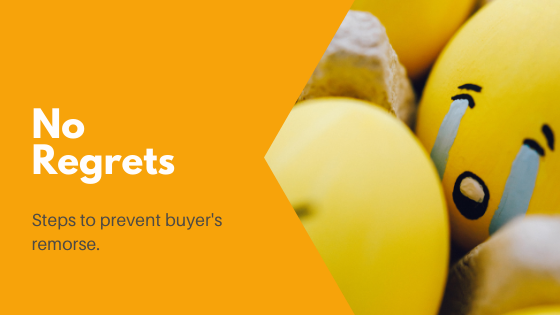Buyer’s remorse is not a sentiment you want associated with your brand.

What is buyer’s remorse?
At some point or another, we’ve all encountered buyer’s remorse—that feeling of regret that sinks in after we’ve made a purchase.
Obviously no one enjoys or wants to feel buyer’s remorse. But it is very common and, according to science, perfectly normal.
It riddles the mind with thoughts like:
- Did I really need this item?
- Could I have found this product / service at a better price?
- Should I have waited for this to go on sale?
- What if there’s actually a better alternative to this?
You may feel regret for something as unassuming as a cup of coffee (that disappointed you) or for something more complex like the purchase of a washing machine.
But for the most part, buyer’s regret is more prevalent in high-involvement purchases. For instance: when what you buy involves a bigger risk, requires more effort to acquire, or is a large commitment.
In other words, the regret is heavier when we’ve invested a lot of time and money into the purchase; if bargaining was involved; or if we have to live with what we bought for a long time (such as a house or car).
What causes buyer’s regret?
It stems from our inherent desire to avoid risks—or anything that might bring about negative consequences.
That means we’re more likely to encounter remorse when:
- We are faced with having to choose between similar offers
- It is difficult to differentiate between brands
- There’s a lack of information or when the information was misleading
- The item doesn’t meet expectations
Clearly, regret is not an emotion you want associated with your brand.
It’s a negative feeling that (1) isn’t great for your reputation and (2) can affect future sales because it makes the customer want to return the product or, even worse, discourages him from buying from you again.

How to avoid buyer’s remorse: what your business can do
Customer satisfaction is key to your long-term success. Unsurprisingly, part of that satisfaction comes from feeling joy or pride about a purchase—not regret.
If you want your brand to be associated with positive emotions, you need to do two things:
- Minimize the pain of paying that consumers feel when they make a purchase;
- Eliminate reasons shoppers might regret their decision to buy from you.
The following tips are a great starting point to stop customers from feeling buyer’s remorse.
Tip #1: Allow testing
Give customers the chance to touch, try, and interact with your product before committing to a purchase.
When you allow customers to try a product / service first, that gets rid of the perceived risk of committing to it. Why? Because they can see for themselves if they like it and that significantly lowers the chance of feeling any regret after.
For example:
- Invite users to take advantage of a free trial, so they can evaluate the product / service properly.
- Give shoppers the chance to test your products out in person like with makeup and perfume testers.
- Let customers taste your food products with free bite-sized samples at local supermarkets.
Here’s how a mattress brand does it in the real world:

Tip #2: Write proper product / service descriptions
One of the most common reasons shoppers feel buyer’s remorse is because what was purchased didn’t live up to expectations.
There’s nothing quite as disappointing as excitedly anticipating one thing (based on the product copy) and ending up with something different or unexpected instead.
I mean, that’s a sure-fire way to invite a ton of negative reviews!
That’s why there’s a lot riding on your e-commerce copy.
It has to be appealing, complete, and accurate. It must also be optimized for search engines. And it has to earn customer trust as well as prevent buyer’s remorse—all while actually convincing readers to buy now!
Here are a few superb examples of product descriptions for inspiration. But if you don’t want to take any chances, hire an e-commerce copywriter like me to do the work for you.
Tip #3: Put a premium on customer service
There’s nothing that will reinforce – and exacerbate – even just a tinge of regret than feeling like the company you’ve just purchased from doesn’t care about you.
And when do customers feel that way?
- When they suddenly can’t get a hold of you—or they’re left waiting and waiting and waiting for your reply.
- The customer service representative they talk to isn’t able to respond to their query; allay their concerns; or provide prompt solutions.
- They’re passed from one department to another for a solution.
- The customer is the one putting in all the effort to get in touch with you because your customer service team doesn’t do any follow up.
Don’t give customers any reason to feel regret. Make sure your customer service is on top of their game; they’re helpful, knowledgeable and always quick to respond. No excuses!
Tip #4: Promise less, deliver more
This one’s really simple: manage shoppers’ expectations.
If you promise the world’s greatest thingamajig (but sadly, it’s not) then customers are going to expect the world’s greatest thingamajig—because you’ve hyped it up that way! They’re now excited for exactly that.
A more sustainable approach is to under-promise and over-deliver. Pleasant surprises go a long way!
For example: Rather than promising next-day delivery, let them know their item will be delivered in 2-3 business days. And then surprise / impress them with an earlier arrival!

Tip #5: Give customers the assurance they need
It never hurts to reassure a customer that they made the right choice. After all, YOU are that choice!
Timing is crucial here – you should do this immediately post-purchase, before buyer’s regret can sink in.
How can you do this?
- Thank them for the purchase and reiterate why they’re going to love what they just bought.
- Share a fun fact or little-known benefit about your product.
- Email customers a promo code that they can apply to their next purchase.
Help your customer feel great about their decision to choose you and they’re less likely to regret it.
Tip #6: Make it an experience
Another way to minimize buyer’s regret is by incorporating or marketing an experience.
Experiences are unique. They’re not easily interchangeable. And it’s harder to directly compare them with similar alternatives on the market. Bonus points if the consumer actually enjoyed himself!
If you can achieve all of the above, customers are less likely to regret buying from you.